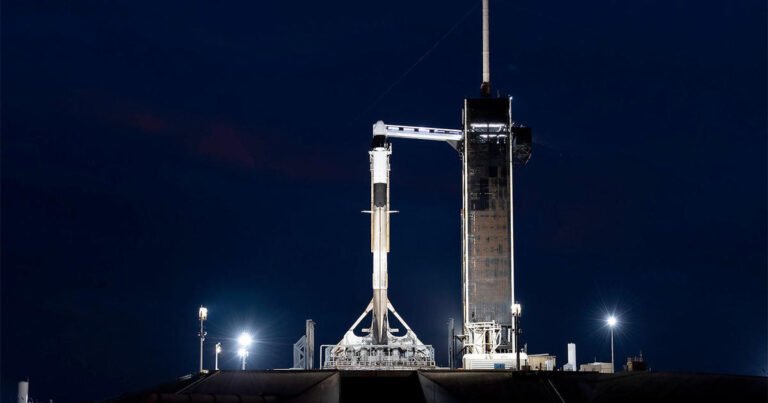
Faced with a frustrating stretch of bad wether locally and off shore, SpaceX geared up Monday for another attempt to launch a privately funded mission — Polaris Dawn — aimed at setting a post-Apollo altitude record and staging the first non-government commercial spacewalk.
Assuming final clearance to proceed, billionaire commander Jared Isaacman, pilot Scott Poteet and two SpaceX engineers, Anna Menon and Sarah Gillis, planned to strap into their SpaceX Crew Dragon capsule just after 1 a.m. EDT Tuesday to await liftoff from pad 39A at the Kennedy Space Center at 3:38 a.m.
SpaceX
Forecasters predicted a 60% chance local weather along Florida’s Space Coast would be no-go. More troubling, perhaps, the outlook was marginal for the off-shore splashdown zones where the crew will have to land at the end of their five-day mission.
Unlike Crew Dragon missions to the International Space Station where astronauts can wait out bad splashdown weather, the Polaris Dawn crew will have no such safe haven and cannot remain in orbit much beyond the planned mission duration.
Even so, Isaacman was encouraged, saying on social media platform Sunday night, “this is a big improvement over the last two weeks. We are getting closer to getting this mission to orbit.”
The flight is the second SpaceX trip to low-Earth orbit chartered by Isaacman, who at 16 founded what became one of the nation’s leading credit card transaction processors. In 2021, he financed and commanded the Inspiration4 mission, the first all-civilian commercial flight to orbit.
SpaceX
The Polaris Dawn mission is the first of three more SpaceX flights Isaacman is funding in cooperation with Musk and the first ever featuring non-government, civilian spacewalks.
The launch was originally planned for Aug. 26, but the flight was delayed 24 hours to complete normal pre-flight processing. Another 24-hour slip then was ordered after engineers discovered a leak in a launch pad umbilical that delivers helium to the booster to push propellants to the rocket’s engines.
But all systems appeared “go” by the afternoon of Aug. 27, with good launch weather expected along Florida’s Space Coast. Those hopes were dashed after a late night weather review. The flight then started slipping day to day pending an improvement in the end-of-mission weather.
“Sometimes, the hardest journeys require the most patience, and we’re ready to wait for the right moment,” Isaacman said at the time. “We know many have traveled to see the launch, and we’re grateful for your support.”
The crew hopes to achieve one of the mission’s primary objectives within a few hours of launch, reaching an orbit with a high point, or apogee, of 870 miles and a low point, or perigee, of 118 miles. In contrast, the International Space Station flies in a circular orbit at an altitude of about 260 miles.
At the high point of the Crew Dragon’s elliptical orbit, Isaacman and company will be farther from Earth than any piloted spacecraft since the end of the Apollo moon program.
The Crew Dragon will only spend about 10 hours in that extremely elliptical orbit. After that, the ship’s thrusters will fire again to lower the apogee to 435 miles.
SpaceX
The mission’s second major objective — the first non-government spacewalk — is planned for flight Day 3 when Isaacman and Gillis, attached to the Crew Dragon by umbilicals and safety tethers, will take turns floating in open space just above the Crew Dragon’s open hatch.
Because the ship does not have an airlock, its cabin will be vented to vacuum before the hatch is opened. Poteet and Menon will also be wearing SpaceX-designed pressure suits, and even though they will not get to stick their helmeted heads outside, they will be counted among the world’s spacewalkers.
The primary goals of the demonstration are to test the new suit’s joints, mobility and comfort to help SpaceX engineers develop lower-cost, easier-to-produce spacesuits for large numbers of people who SpaceX says will one day be venturing to the moon and Mars.
The crew also plans to test a high-speed laser communications system and will carry out a battery of bio-medical experiments throughout the five-day flight to help researchers from more than 30 institutions learn more about the effects of weightlessness.


